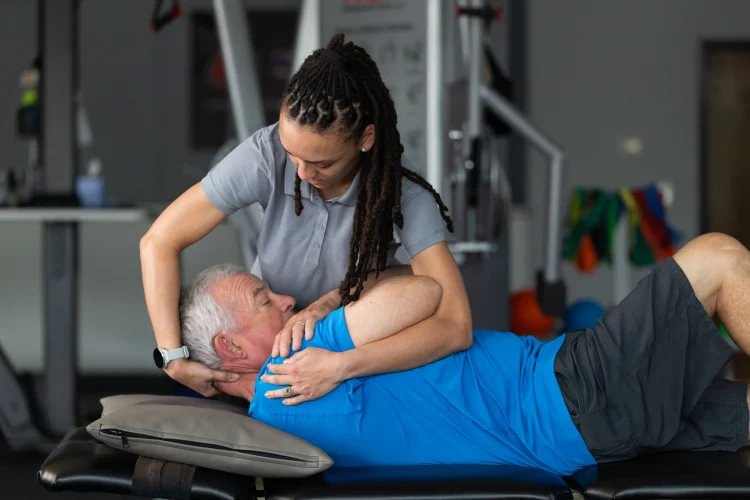[tsf_breadcrumb sep="/" class="breadcrumbs]
Home / Patients / Conditions We Treat / Neck Pain
Neck pain can come from many sources, whether it’s an old injury, a recent car accident, or years of strain. Whatever the cause, we’re here to help you find relief and get back to doing the things you love. Our expert physical therapists assess your condition and develop a plan that targets both pain relief and long-term strength. Through gentle stretches, strengthening exercises, and posture correction, we’ll work together to relieve your discomfort and prevent it from coming back. We’re committed to helping you heal, so you can move through life with ease again.
Neck pain, or cervicalgia, is a common musculoskeletal condition that is characterized by discomfort or stiffness in the cervical spine- the area that supports your head and connects it to your upper body. Neck pain can be localized or radiate into one or both upper extremities. It can range from a full ache to a sharp pain, and may be accompanied by other symptoms such as headaches, limited neck or shoulder mobility, and in severe cases, numbness and tingling in the arms or hands. According to the World Health Organization, neck pain affects 30% to 50% of the general population annually, with women and those over the age of 45 most likely to experience this pain.1 It is also the fourth leading cause of disability worldwide, making it a significant public health concern. Unfortunately, recurrence and chronicity of neck pain are common, recent studies have shown that 50% to 85% of individuals who experience neck pain will have symptoms return 1 to 5 years and complete resolution often isn’t achieved. That’s why it is crucial to be proactive and seek the expertise of a physical therapist early on.
Neck pain’s impact on daily life can be profound. It can interfere with sleep, work, daily tasks, physical activity and even simple tasks like turning your head to change lanes while driving. For many, untreated neck pain becomes a chronic issue that severely impacts them both physically and mentally. Physical therapy offers a non-invasive, safe, and evidence based approach to address both the symptoms and root causes of neck pain.
Neck pain can arise from a wide range of causes, understanding the potential causes and risk factors of neck pain is key to effective treatment and prevention. Below we will discuss common causes, risk factors, and underlying conditions that may contribute to neck pain;


While neck pain can affect anyone, certain factors predispose an individual to developing it or can make recovery more challenging. Recognizing these risk factors can help guide prevention strategies and establish early intervention;
Neck pain presents in a variety of ways and is dependent on the underlying cause, the individuals comorbidities, the structures involved, and the duration of pain. While some might experience acute or intermittent pain that resolves on its own, others might face more chronic, severe pain that significantly impacts their daily life. One of the most common complaints of those who suffer from neck pain is stiffness, which can make it challenging to turn the head fully or to look up or down. In cases of muscle strain, muscle spasms are common and can be quite painful and further limit mobility. Some experience sharp or stabbing pain that is usually brought on by movement, while others report a more dull, aching discomfort. In both instances, this pain can radiate into the shoulders or upper back, causing the individual to experience limited mobility.
Headaches originating from the neck (cervicogenic headaches) are also common and may worsen with certain postures or movements. If nerves are involved, pain may radiate into the arms and hands and is often accompanied by numbness or tingling. Physical therapists (PT) are highly trained to assess these symptoms and to make a differential diagnosis between typical musculoskeletal neck pain and more serious underlying conditions.
During the initial evaluation, which we will discuss later in this article, they are able to screen for red flag symptoms such as unexplained weight loss, fever, night pain, recurrent trauma, or any recent neurological changes. These signs could indicate more serious conditions such as spinal cord compression or infection and warrant referral to a specialized medical provider. A PT’s ability to identify these warning signs ensures patients receive timely, safe, and effective care.

The diagnosis of neck pain requires a careful clinical evaluation. If you are experiencing persistent neck pain that impairs your day to day life, limited range of motion, tingling, or weakness in the arms, you should consider seeing a PT. In most cases, it is appropriate to consult a PT prior to seeing a doctor, especially when no red flag symptoms are present. PTs are trained to identify musculoskeletal causes of neck pain and can refer to a physician if a more serious cause is suspected. During an initial evaluation, a PT will begin by collecting a thorough past medical history to gain insight into the nature of the neck pain. This includes identifying any factors that aggravate or alleviate pain, reviewing lifestyle habits, and noting any underlying health conditions that could be contributing to the issue. Physical therapists also use a hands-on approach to evaluate neck pain. This often includes assessing posture, strength or the neck and upper extremities, ROM, joint mobility, and functional movement patterns.
A PT might also perform a few special tests that can aid them in making an appropriate differential diagnosis. If a PT notes any red flag symptoms or conservative treatment fails to resolve symptoms, referral to a physician might be appropriate. Oftentimes, this will lead to the use of imaging. While diagnostic tests such as X-rays or MRIs are sometimes used to assess neck pain, their findings don’t always correlate with the individual’s symptoms.
It’s not uncommon for someone to have clean imaging and still experience significant neck pain, or to show abnormalities like disc herniation or arthritis without any pain at all. Unless there is a clear structural issue-such as a fracture or tumor-imaging alone rarely identifies the root cause of the pain.
There are a variety of treatment options available for managing neck pain, ranging from conservative treatment to surgical intervention. The appropriate treatment approach depends on the underlying cause, severity, duration, and the patient’s overall goals.
Neck pain prevention often comes down to daily habits and lifestyle choices. One key strategy is incorporating regular position breaks throughout the day, especially if your job requires a lot of sitting. The saying “your next position is your best position” highlights that staying in one static posture-regardless of how ergonomically sound-can lead to discomfort and muscle imbalances over time.
Changing position frequently, especially during periods of prolonged sitting or computer use, helps reduce strain on the neck and upper back. In addition to postural awareness, lifestyle factors play a significant role in neck pain prevention. Prioritizing sleep and ensuring at least 7-8 hours of quality sleep each night gives the body time to recover and repair. Other tools to prevent neck pain include stress management, maintaining a healthy diet, and staying active through regular and consistent exercise. Seeing a PT at the first sign of neck pain- not after it becomes debilitating- can also help address symptoms early and prevent more serious problems from developing.

Living with neck pain can affect many aspects of your life but fortunately there are many effective ways to help manage symptoms. Coping strategies such as applying heat or ice, practicing gentle stretches within a pain free range, adjusting posture, and using ergonomic supports can provide relief during flare-ups. Stress management techniques such as medication, guided breathing, and regular exercise also play an important role in reducing muscle tension that contributes to neck pain.
It is important to remember that oftentimes, gentle movement is more beneficial than complete rest as it improves circulation to the affected tissue, reducing stiffness in the neck. It is also important to recognize that neck pain is not one size fits all, which is why seeking out a PT who will develop a personalized treatment plan is crucial. Early professional intervention can prevent acute pain from becoming chronic and improve long-term outcomes. Investing in your health through consistent care, healthy lifestyle choices, and proactive pain management strategies can significantly enhance your quality of life.
Physical therapy is a highly effective approach for addressing neck pain as it targets the underlying cause rather than simply masking the symptoms. A PT utilizes a combination of techniques such as manual therapy, soft tissue mobilization, joint manipulation, and modalities such as dry needling and heat therapy to improve pain and mobility.
Personalized exercises are prescribed to aid in strengthening the muscles surrounding the neck to improve stability of the spine.7 Stretching is also a crucial component to a well rounded treatment plan and will target areas of tension or muscular imbalance noted.8 The main goal of physical therapy for neck pain is to reduce pain, restore a functional range of motion, improve strength, reduce future flare-ups- all while improving the individuals quality of life. Early intervention and consistency in following a tailored program are key to achieving long lasting results.
Yes, using a supportive pillow and maintaining a comfortable spine alignment while sleeping can help alleviate neck discomfort.
Yes, using a supportive pillow and maintaining a comfortable spine alignment while sleeping can help alleviate neck discomfort.
Yes, using a supportive pillow and maintaining a comfortable spine alignment while sleeping can help alleviate neck discomfort.